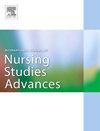A nomogram and risk stratification for predicting subsyndromal delirium in elderly patients in a post-anaesthesia care unit: A prospective cohort study
IF 3.1
Q1 NURSING
International Journal of Nursing Studies Advances
Pub Date : 2025-08-06
DOI:10.1016/j.ijnsa.2025.100402
引用次数: 0
Abstract
Background
Subsyndromal delirium, as a transitional state of postoperative delirium, does not meet the diagnostic threshold for delirium but independently contributes to adverse outcomes in elderly patients. Early identification and intervention can effectively prevent disease progression.
Objective
This study focuses on the post-anesthesia care unit, a critical window period for postoperative recovery, aiming to develop a reliable risk prediction model.
Design
A prospective cohort study.
Methods
Subsyndromal delirium was assessed with the Confusion Assessment Method at 30 min post-extubation and pre-transfer. The least absolute shrinkage and selection operator and multivariate logistic regression were applied to screen independent predictors and construct a nomogram. The performance of the model was evaluated by discrimination, calibration and clinical utility. Patients were subsequently divided into low-risk and high-risk subgroups.
Results
The overall incidence of subsyndromal delirium in 2636 elderly patients in the post-anesthesia care unit was 18.6 %. Age, latest neutrophil to lymphocyte ratio, nighttime surgery, intraoperative hypothermia, patient-controlled analgesia usage, and duration of mechanical ventilation in the post-anesthesia care unit were identified as independent risk factors for predicting subsyndromal delirium. The areas under the ROC curve of the model were 0.904 (95 % CI: 0.878–0.931) and 0.850 (95 % CI: 0.814–0.886) in the training and validation cohorts, respectively. The calibration curves and decision curve analysis demonstrated good consistency and clinical value. Significant differences in subsyndromal delirium rates were observed between the low-risk and high-risk groups (P < 0.001).
Conclusions
The developed nomogram model incorporating six clinical variables demonstrated excellent discrimination and calibration, with its risk stratification effectively identifying high-risk subsyndromal delirium patients.
预测麻醉后护理病房老年患者亚综合征性谵妄的nomogram和risk分层:一项前瞻性队列研究
背景:亚综合征性谵妄作为术后谵妄的过渡状态,不符合谵妄的诊断阈值,但对老年患者的不良结局有独立的影响。早期识别和干预可有效预防疾病进展。目的研究麻醉后护理病房,这是术后恢复的关键窗口期,旨在建立可靠的风险预测模型。设计前瞻性队列研究。方法拔管后和转移前30min采用神志不清评估法对亚综合征性谵妄进行评估。最小绝对收缩和选择算子和多元逻辑回归应用筛选独立预测因子和构建nomogram。通过鉴别、校准和临床应用来评价模型的性能。随后将患者分为低危和高危亚组。结果2636例麻醉后护理单元老年患者亚综合征性谵妄的总发生率为18.6%。年龄、最新中性粒细胞与淋巴细胞比值、夜间手术、术中低温、患者自控镇痛的使用以及麻醉后护理单元机械通气时间被确定为预测亚综合征性谵妄的独立危险因素。模型在训练组和验证组的ROC曲线下面积分别为0.904 (95% CI: 0.878 ~ 0.931)和0.850 (95% CI: 0.814 ~ 0.886)。校正曲线与决策曲线分析结果一致性好,具有临床应用价值。低危组和高危组在亚综合征谵妄发生率上有显著差异(P <;0.001)。结论所建立的包含6个临床变量的nomogram模型具有良好的辨别性和校准性,其风险分层能有效识别高危亚综合征型谵妄患者。
本文章由计算机程序翻译,如有差异,请以英文原文为准。
求助全文
约1分钟内获得全文
求助全文
来源期刊

International Journal of Nursing Studies Advances
Nursing-General Nursing
CiteScore
5.80
自引率
0.00%
发文量
45
审稿时长
81 days
 求助内容:
求助内容: 应助结果提醒方式:
应助结果提醒方式:


